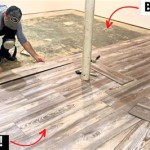Can You Put Vinyl Plank Flooring Over Concrete?
When it comes to flooring options for your home, vinyl plank flooring has become increasingly popular due to its durability, ease of maintenance, and cost-effectiveness. However, if you have a concrete subfloor, you may wonder if you can install vinyl plank flooring over it.
The answer is yes, you can install vinyl plank flooring over concrete, but it requires proper preparation and installation techniques to ensure long-lasting results. Here's what you need to know.
Preparing the Concrete Subfloor
Before installing vinyl plank flooring, it is essential to prepare the concrete subfloor properly to ensure a smooth and level surface. These steps include:
- Clean the Subfloor: Remove any dirt, debris, or old flooring materials using a vacuum cleaner or broom.
- Repair Cracks and Holes: Fill any cracks or holes in the concrete using a concrete patching compound.
- Level the Subfloor: If the subfloor is uneven or sloping, use a self-leveling compound to create a smooth and level surface.
- Install a Moisture Barrier: Concrete is a porous material that can release moisture over time. To prevent moisture from damaging your vinyl plank flooring, install a moisture barrier, such as a polyethylene sheet, between the subfloor and the flooring.
Installing Vinyl Plank Flooring
Once the subfloor is properly prepared, you can proceed with installing the vinyl plank flooring. Follow these steps:
- Plan the Layout: Determine the starting point for your flooring and lay out a few planks to ensure a straight and even row.
- Apply Adhesive: Spread an appropriate adhesive to the subfloor using a trowel. Follow the manufacturer's instructions for the proper adhesive application.
- Install the First Row: Carefully place the first plank along the planned starting point and gently press it into the adhesive.
- Continue Installing Rows: Interlock the subsequent planks by aligning the tongue and groove edges and pressing them together.
- Trim Planks: Use a utility knife to trim the last plank in each row to fit the space.
- Apply Moldings: Install baseboard moldings, quarter rounds, or other moldings as needed to finish the flooring.
Tips for Successful Installation
Here are some additional tips to help ensure a successful installation:
- Use a High-Quality Adhesive: The adhesive you use plays a crucial role in the longevity of your flooring. Choose a high-quality adhesive specifically designed for vinyl plank flooring installation.
- Allow Proper Acclimation: Allow the vinyl plank flooring to acclimate to the room temperature for 24-48 hours before installation to prevent buckling or warping.
- Cut the Planks Accurately: Precise cuts ensure a tight fit and a seamless appearance. Use a sharp utility knife and a straight edge for accurate cutting.
- Roll or Tap the Planks: After installing each plank, use a roller or tapping block to ensure a firm bond with the adhesive and prevent air pockets.
- Allow Proper Curing Time: Allow the adhesive to cure completely before walking on or moving furniture on the new flooring. Follow the manufacturer's recommendations for curing times.
By following these guidelines, you can successfully install vinyl plank flooring over concrete in your home, creating a durable, attractive, and easy-to-maintain floor that will last for years to come.

How To Prepare A Concrete Floor For Vinyl Flooring Parrys

How To Install Vinyl Plank Flooring On Concrete Step By Guide

How To Install Vinyl Plank Flooring On Concrete Step By Tutorial

Tips For Installing Vinyl Plank Over Concrete Floors Lemon Thistle

Easy Ways To Install Vinyl Plank Flooring On Concrete

How To Install Vinyl Plank Flooring On Concrete Base

How To Install Vinyl Plank Flooring On Concrete Step By Tutorial

Easy Ways To Install Vinyl Plank Flooring On Concrete

Tips And Tricks For Installing Vinyl Plank Over Concrete Floors Riverbend Interiors

Installing Laminate Flooring Over Concrete The Ultimate Guide Aa Floors
See Also







